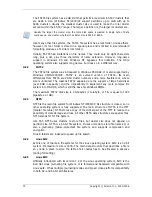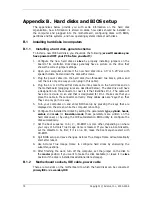
The FAT16 file system has a 2GB limit that permits a maximum 65,507 clusters that
are 32Kb in size. (Windows NT/2000/XP support partitions up to 4GB with up to
64Kb clusters). Usually the smallest cluster size is used to make the total cluster
amount within the 65,507 range. The larger a partition is, the larger its clusters are.
Usually the larger the cluster size, the more disk space is wasted. A single byte of data
could use up one cluster, whether the cluster size is 32Kb or 64Kb.
Like many other file systems, the FAT16 file system has a root folder. Unlike others,
however, its root folder is stored in a special place and is limited in size (standard
formatting produces a 512-item root folder).
Initially, FAT16 had limitations on file names. They could only be eight characters
long, plus a dot, plus three characters of name extension. However, long-name
support in Windows 95 and Windows NT bypasses this limitation. The OS/2
operating system also supports long names, but does so in a different way.
A.2.2 FAT32
The FAT32 file system was introduced in Windows 95 OSR2. It is also supported by
Windows 98/Me/2000/XP. FAT32 is an evolved version of FAT16. Its main
differences from FAT16 are 28-bit cluster numbers and a more flexible root, whose
size is unlimited. The reasons FAT32 appeared are the support of large hard disks
(over 8GB in capacity) and the impossibility to implement any more complex file
system into MS-DOS, which is still the base for Windows 98/Me.
The maximum FAT32 disk size is 2 terabytes (1 terabyte, or TB, is equal to 1024
gigabytes, or GB).
A.2.3 NTFS
NTFS is the main file system for Windows NT/2000/XP. Its structure is closed, so no
other operating system is fully supported. The main structure of NTFS is the MFT
(master file table). NTFS stores a copy of the critical part of the MFT to reduce the
possibility of data damage and loss. All other NTFS data structures are special files.
NTFS stands for NT File System.
Like FAT, NTFS uses clusters to store files, but cluster size does not depend on
partition size. NTFS is a 64-bit file system. It uses unicode to store file names. It is
also a journaling (failure-protected) file system, and supports compression and
encryption.
Files in folders are indexed to speed up file search.
A.2.4 Linux
Ext2
Ext2 is one of the main file systems for the Linux operating system. Ext2 is a 32-bit
system. Its maximum size is 16TB. The main data structure that describes a file is
an i–node. A place to store the table of all i-nodes has to be allocated in advance
(during formatting).
A.2.5 Linux
Ext3
Officially introduced with its version 7.2 of the Linux operating system, Ext3 is the
Red Hat Linux journaling file system. It is forward and backward compatible with
Linux ext2. It has multiple journaling modes and broad cross-platform compatibility
in both 32- and 64-bit architectures.
70 Copyright © Acronis, Inc., 2000-2006












































